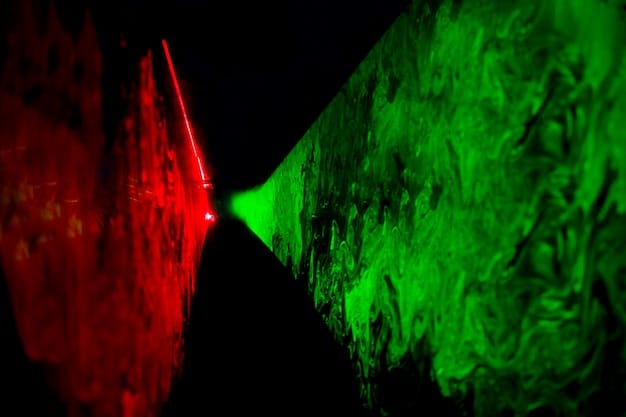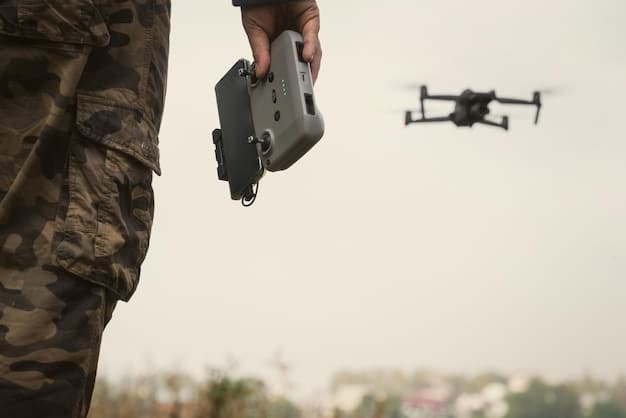Persian Gulf War: Precision Bombing’s Impact on Modern Warfare

The Persian Gulf War marked a turning point in modern warfare due to its unprecedented use of precision bombing, which significantly altered military strategies and technological advancements in target engagement and collateral damage reduction.
The Persian Gulf War: How Did Precision Bombing Change Modern Warfare? This conflict showcased a dramatic shift in military strategy, emphasizing accuracy and minimizing collateral damage in ways never before seen.
The Dawn of Smart Warfare
The Persian Gulf War, often referred to as Operation Desert Storm, heralded a new era in military engagements. This conflict saw the widespread deployment of precision-guided munitions, fundamentally changing how wars are fought and won.
The Technological Leap
Prior to the Gulf War, bombing campaigns relied heavily on conventional, unguided bombs. These were often inaccurate, leading to widespread destruction and significant civilian casualties. Precision bombing, however, introduced a new level of accuracy.
The technological leap involved several key innovations, including:
- Laser-Guided Bombs: These bombs used lasers to guide them to their targets, drastically improving accuracy.
- GPS-Guided Munitions: Utilizing satellite technology, these weapons could strike targets with pinpoint precision, regardless of weather conditions.
- Advanced Targeting Systems: Sophisticated systems allowed for real-time intelligence and target identification, ensuring that the right targets were engaged.
This shift towards precision was not merely a technological upgrade; it represented a paradigm shift in military doctrine. The ability to strike specific targets with minimal collateral damage became a central tenet of modern warfare.
Strategic Impact on the Battlefield
The introduction of precision bombing had a profound strategic impact on the battlefield during the Persian Gulf War. It enabled coalition forces to weaken Iraqi military capabilities systematically while minimizing civilian casualties.
Precision bombing allowed for the strategic targeting of key infrastructure and military assets, including:
- Command and Control Centers: Disrupting the Iraqi military’s ability to coordinate and communicate.
- Air Defenses: Neutralizing Iraq’s air defense systems to ensure air superiority.
- Military Bases and Supply Depots: Eliminating key logistical hubs and reducing Iraq’s ability to resupply its forces.
The effectiveness of these strikes was amplified by the element of surprise. Iraqi forces were unprepared for the level of accuracy and sophistication demonstrated by coalition forces.
The strategic impact extended beyond the immediate battlefield. By demonstrating the potential of precision bombing, the Gulf War influenced military planning and procurement decisions worldwide.
Minimizing Collateral Damage and Civilian Casualties
One of the most significant aspects of precision bombing is its potential to minimize collateral damage and civilian casualties. While no military action is entirely without risk to civilians, precision-guided munitions offered a significant improvement over conventional bombing methods.
The ability to strike specific targets with greater accuracy meant that:
- Hospitals and Schools: Could be avoided more effectively, reducing the risk of civilian casualties.
- Essential Infrastructure: Like power plants and water treatment facilities, could be spared when not directly involved in military operations.
- Cultural Sites: Historical and cultural landmarks could be protected from unnecessary destruction.

However, it’s crucial to acknowledge that even with precision bombing, civilian casualties are not entirely avoidable. Errors in intelligence, technical malfunctions, and unforeseen circumstances can still lead to unintended consequences.
The concept of minimizing collateral damage through precision bombing has since become a key ethical consideration in modern military operations. It has spurred further development in weapon technology and targeting strategies.
Lessons Learned and Adaptations in Military Doctrine
The Persian Gulf War provided invaluable lessons that have since shaped military doctrine and training. The success of precision bombing highlighted the need for continuous technological advancement and strategic adaptation.
Key lessons learned include:
The Importance of Air Superiority
Maintaining control of the skies is crucial for conducting effective precision bombing campaigns. Neutralizing enemy air defenses and achieving air superiority allows for safer and more accurate targeting.
The Need for Real-Time Intelligence
Accurate and up-to-date intelligence is essential for identifying targets and assessing the effectiveness of strikes. Real-time intelligence allows for adjustments to be made during operations, improving overall outcomes.
The Role of Training and Simulation
Proper training and simulation are critical for ensuring that military personnel can effectively operate and maintain precision-guided munitions. Realistic training scenarios help personnel prepare for the complexities of modern warfare.
These lessons have led to significant adaptations in military doctrine, with an increased emphasis on joint operations, technological integration, and continuous training.
Evolution of Precision Bombing Technology
Since the Persian Gulf War, precision bombing technology has continued to evolve at a rapid pace. Advancements in guidance systems, sensor technology, and data processing have further enhanced the accuracy and effectiveness of these weapons.
Notable advancements include:
- Improved GPS Accuracy: Enhanced GPS technology has further reduced targeting errors, allowing for even greater precision.
- Multi-Mode Guidance Systems: Combining multiple guidance systems, such as laser and GPS, to provide redundancy and improve accuracy in diverse environments.
- Advanced Sensor Technology: Using advanced sensors to identify and track targets in all weather conditions and at night.
These advancements have not only improved the accuracy of precision bombing but have also expanded its applicability to a wider range of targets and scenarios.

The evolution of precision bombing technology is an ongoing process, driven by the need to address emerging threats and minimize the risks of modern warfare.
Ethical Considerations and Future Implications
The use of precision bombing raises important ethical considerations regarding the conduct of warfare. While these weapons offer the potential to minimize civilian casualties, they also raise questions about the proportionality of force and the potential for unintended consequences.
Ethical considerations include:
Proportionality of Force
Ensuring that the use of force is proportionate to the military objective and that all reasonable precautions are taken to avoid civilian casualties.
Transparency and Accountability
Maintaining transparency in targeting decisions and holding military personnel accountable for any unintended harm to civilians.
Technological Advancement
Guiding the development and deployment of new technologies in a way that minimizes the risk of unintended consequences and promotes ethical warfare.
Looking ahead, the future of precision bombing will likely be shaped by further advancements in artificial intelligence and automation. These technologies offer the potential to further enhance accuracy and reduce the risks of human error, but they also raise new ethical questions about the role of machines in warfare.
| Key Aspects | Brief Description |
|---|---|
| 💡 Technological Advancements | The war saw the introduction of laser-guided bombs & GPS-guided munitions. |
| 🎯 Strategic Targeting | Key military infrastructure was targeted minimizing civilian impact. |
| 🛡️ Collateral Damage Reduction | Precision bombing aimed to reduce civilian casualties compared to past strategies. |
| ✈️ Evolution in Doctrine | The Gulf War influenced military planning and procurement decisions worldwide. |
Frequently Asked Questions
▼
Precision bombing in the Persian Gulf War referred to the use of guided munitions, such as laser-guided and GPS-guided bombs, to accurately strike specific targets while minimizing collateral damage.
▼
By targeting specific military assets and infrastructure, precision bombing aimed to minimize harm to non-military targets, thus reducing the risk of civilian casualties compared to traditional bombing.
▼
Key technologies included laser-guided bombs, GPS-guided munitions, and advanced targeting systems that allowed for real-time intelligence and precise target identification during the Persian Gulf War.
▼
Since the conflict, precision bombing has evolved through improved GPS accuracy, multi-mode guidance systems, advanced sensor tech, enhancing target accuracy and reducing collateral damage in various situations.
▼
Ethical considerations associated with precision bombing include ensuring proportionality of force, maintaining transparency and accountability in targeting decisions, and guiding technological advancements to minimize unintended consequences.
Conclusion
The Persian Gulf War served as a proving ground for precision bombing, demonstrating its transformative impact on modern warfare. By enabling more accurate targeting and reducing collateral damage, precision bombing has reshaped military strategies, technological advancements, and ethical considerations in conflict. The legacy of this conflict continues to influence military doctrine and technological development today.





